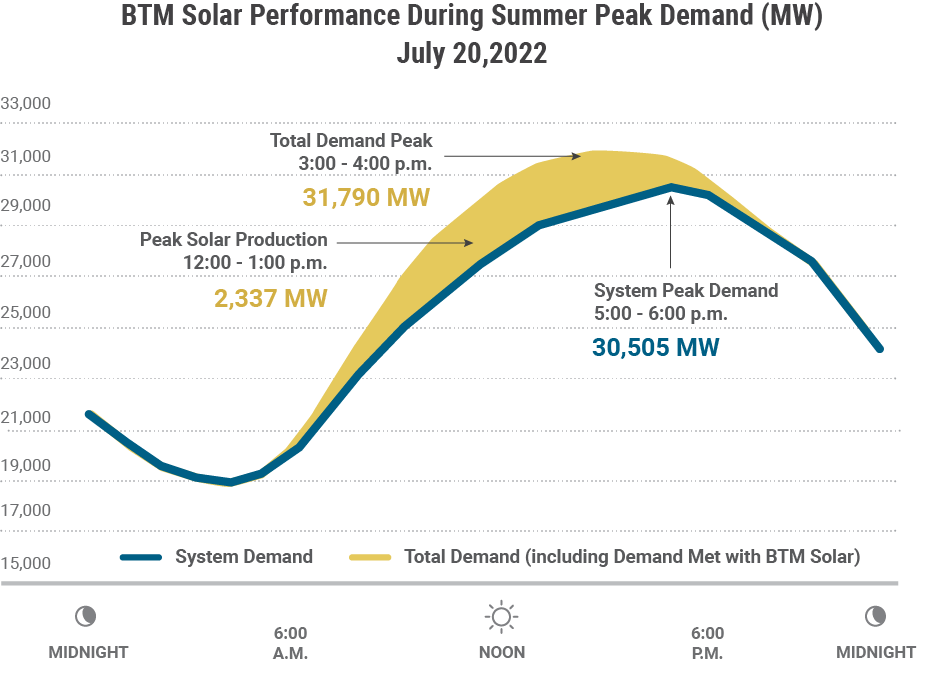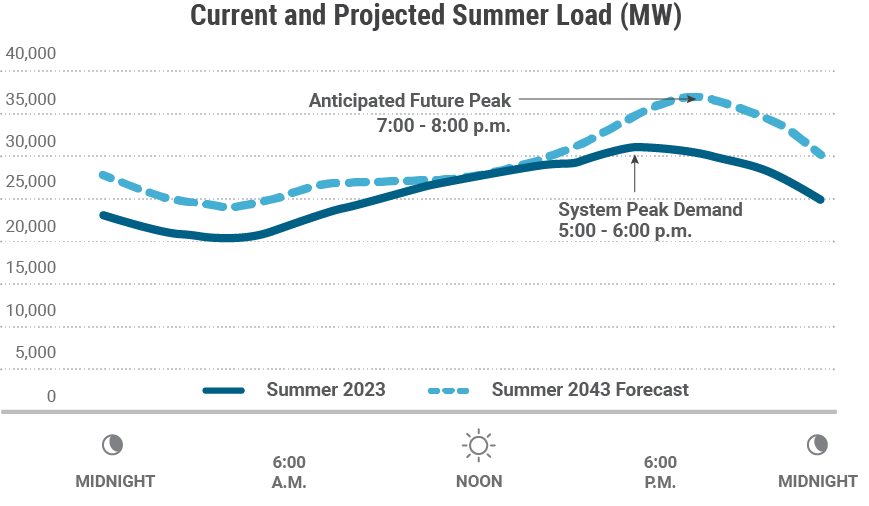Shaving Peaks with the Sun

New York State has embarked on an ambitious journey towards a zero-emissions power grid by 2040. The timeframe seems so distant and the goal so overwhelming that it’s hard to know sometimes if we’re making progress. While plenty of work remains to decarbonize the grid, in some ways many of the small steps the state has already taken are contributing to significant changes in how the grid is supplied.
Let’s take a look at solar energy, for example.
New York State established a goal of installing 10,000 MW of distributed solar resources by 2030. As of 2022, there were more than 4,200 MW installed – a number that is growing rapidly.
Many people are familiar with distributed, or behind-the-meter, solar energy through residential rooftop installations. These roof-mounted solar panels supply electricity to the homes they are attached to, incrementally reducing, or “shaving” the amount of power that must be supplied by the power grid that the NYISO operates. Other types of distributed solar installations, such as community solar projects, supply the distribution grid directly but have the same effect of reducing demand on the power grid operated by the NYISO.
Roof-top installations typically have a maximum capacity of less than 10 kilowatts while the NYISO may be balancing 30,000 megawatts or more of system demand during peak demand periods. While each installation is virtually invisible to the NYISO, the cumulative effect of thousands of installations across the state is significant. In fact, the collective contribution from distributed solar resources regularly exceeds that of any individual generator supplying the grid.
This is significant because, as the figure below shows, distributed solar resources work to shave the mid-day peak demand for electricity, reducing the amount of generation the NYISO must dispatch to supply the grid. Given the NYISO’s market design and the generators available throughout New York State; that avoided generation is likely to be fossil-fuel based.

The figure shows the contribution of distributed solar resources during the peak demand day observed on July 20, 2022. The first thing to note is how distributed solar energy production contributes to electricity demand throughout the daytime, supplying electricity directly to customers above and beyond what is being supplied by the grid.
The second thing to note is how the energy production from these distributed solar resources changes throughout the day. The first indication of production begins around 5:00 AM as the sun emerges from behind the horizon. As the sun sets at the end of the day, these solar resources produce their last megawatts of energy from 8:00-9:00 PM. What happens in between these hours is significant.
Noontime: Solar Energy Production Peaks
From noon to 1:00 PM, distributed solar energy production peaked at more than 2,300 MW, meaning the NYISO did not have to dispatch 2,300 MW of generation during that timeframe. For perspective, of the hundreds of generators that the NYISO can dispatch to supply the grid, only one is capable of producing that much power all at once – the Niagara hydro project, which has a nameplate capacity of more than 2,800 MW.
3:00-4:00 PM: Total Consumer Demand Peaks
While solar production began to gradually diminish after noontime, consumer demand for electricity continued to climb. By 3:00 PM, total demand for electricity, represented by the system demand plus the contribution of distributed solar resources, peaked for the day at 31,790 MW. The contribution from distributed solar installations declined from its noon-time peak, but still shaved nearly 2,000 MW from the total load that the NYISO would otherwise supply by dispatching generation. As a result, system demand at this time remained below 30,000 MW.
5:00-6:00 PM: System Demand Peaks
As the afternoon progressed, both solar energy output and total electricity demand declined. But the decline in solar output has the effect of shifting the demand being met by distributed solar resources back to the grid. So, even as total demand for electricity is declining, demand for electricity supplied by the grid is rising. On this day, demand for electricity supplied by the grid peaked at 30,505 MW in the 5:00-6:00 PM timeframe. During this time, production from distributed solar resources declined to little more than 1,000 MW.
As distributed solar resources continue to expand in New York, they will reshape demand patterns and alter how the NYISO dispatches generation to satisfy demand. For instance, models of the grid of the future suggest that distributed solar resources will contribute towards shifting system peak demand periods later in the day. The figure below compares present-day system demand in the summer with system demand anticipated in 2043, when more than 10,000 MW of distributed solar is assumed to be installed throughout the state. The combination of distributed solar and new demands due to electrification will lead to peak demand periods occurring later in the day when solar resource production is greatly diminished.

Distributed solar resources are a key element of reducing the grid’s reliance on fossil fuels and, as the portfolio continues to grow, solar will continue to displace output from fossil fuel generation by shaving demand on the grid. On May 18, 2023, New York’s distributed solar resources achieved a record production of 3,200 MW, accounting for roughly 20% of New York’s electricity demand at that time. But while it displaces fossil fuel generation throughout the day, it cannot replace the need for dispatchable generation resources to meet the system’s reliability needs.
The ability to dispatch generation is a key distinction between solar resources and hydro or fossil fuel generation. Energy production from distributed solar resources is determined by the angle of the sun, cloud cover, and shadows from trees or other buildings – factors beyond the NYISO’s control. Ultimately, reliably integrating these distributed solar resources requires balancing their output with controllable resources that can be ramped up or down in response to system needs.
